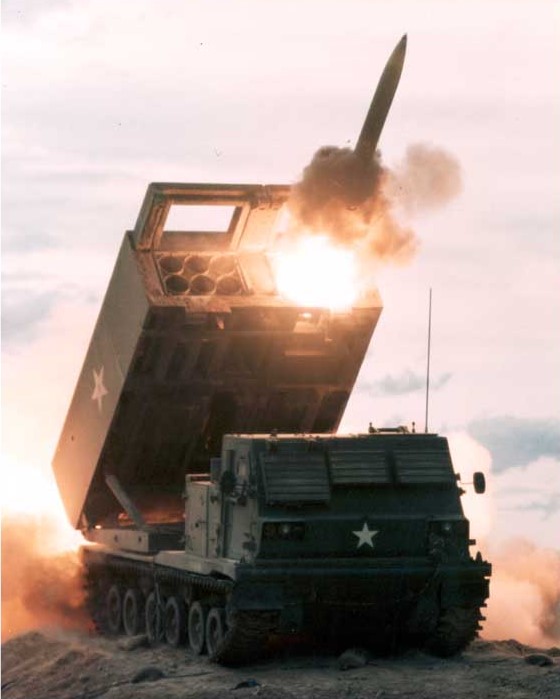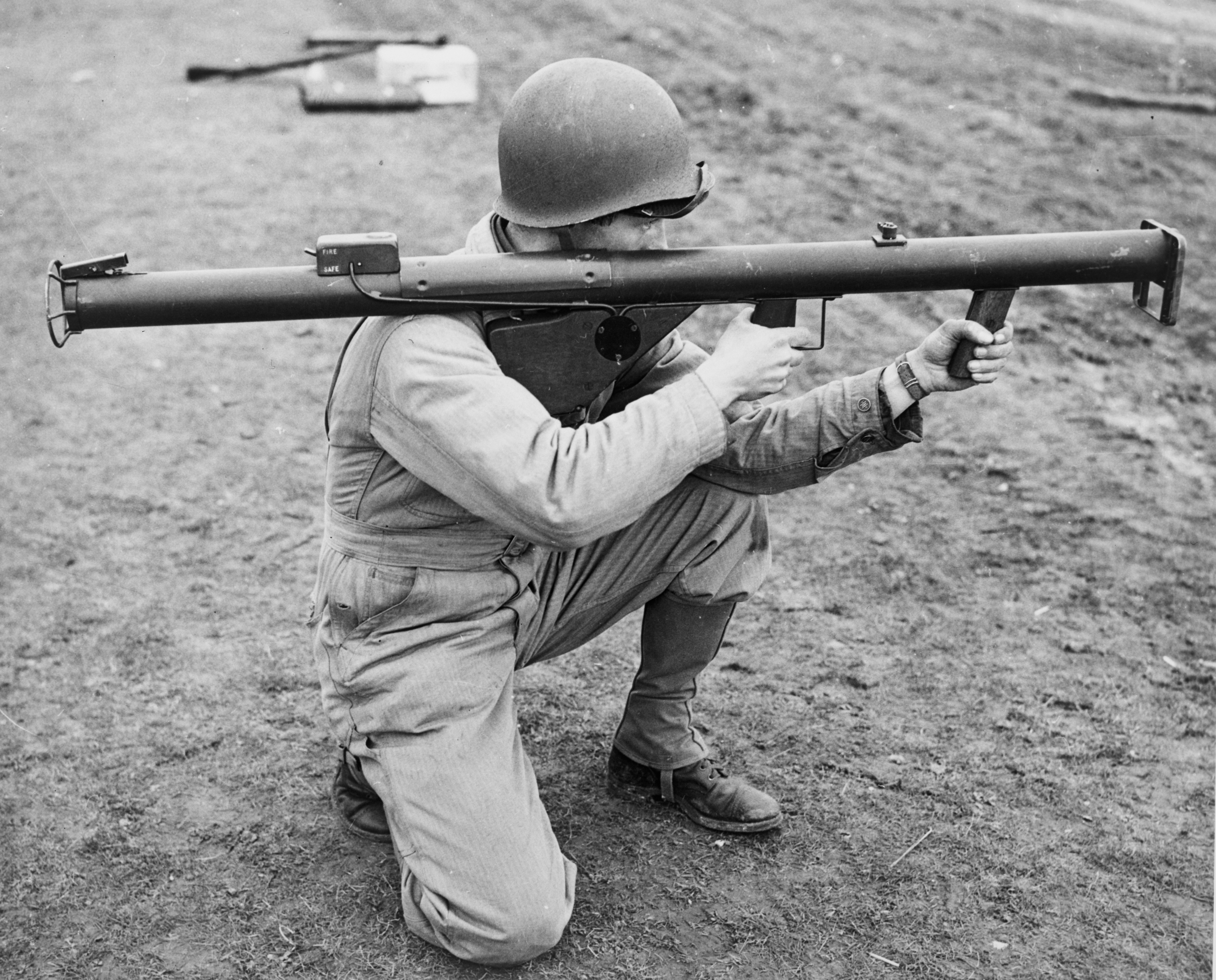|
T22 (rocket)
The M8 was a rocket developed and used by the United States military during World War II. Produced in the millions, it was fired from both air- and ground-based launchers; it was replaced by the M16 (rocket), M16 rocket in 1945. Development The first modern research into military solid-propellant rockets in the United States was conducted by Colonel Leslie Skinner at the Aberdeen Proving Ground in 1932. Little interest was shown by the US Armed Forces however, until the introduction of a British Unrotated projectile, anti-aircraft rocket; both nations exchanged their research data before the United States entered World War II. The M8 rocket was developed by the National Defense Research Committee and the Army Ordnance Department in the early 1940s at Picatinny Arsenal. The specifications were agreed in the summer of 1941 after examining equivalent British rockets. Skinner produced the first prototypes which were tested at Aberdeen that fall, improvised from old fire extinguisher ... [...More Info...] [...Related Items...] OR: [Wikipedia] [Google] [Baidu] |
RS-82 (rocket Family)
RS-82 and RS-132 (Reaktivny Snaryad; Russian: Реактивный Снаряд; rocket-powered projectile) were unguided rockets used by Soviet military during World War II. Development Design work on RS-82 and RS-132 rockets began in the late 1920s, by the Gas Dynamics Laboratory (GDL) led by Georgy Langemak, and including Nikolai Tikhomirov, Vladimir Artemiev, Boris Petropavlovsky, Yuriy Pobedonostsev, and others. The 82 mm (3.2 in) and 132 mm (5.2 in) diameters were chosen because the standard smokeless gunpowder charge used at the time was 24 mm (0.94 in) in diameter and seven of these charges fitted into an 82 mm cylinder. The first test-firing of a solid fuel rocket was carried out in March 1928, which flew for about 1,300 meters and in 1932 in-air test firings of RS-82 missiles from an Tupolev I-4 aircraft armed with six launchers successfully took place. In 1933 GDL became part of the Reactive Scientific Research Institute, where developm ... [...More Info...] [...Related Items...] OR: [Wikipedia] [Google] [Baidu] |
Leslie Skinner
Colonel Leslie Alfred Skinner LOM (April 21, 1900 – November 2, 1978) was an American rocket engineer. He played a leading role in the development of several rocket propelled weapons during World War II, notably the first shoulder-fired missile system, the bazooka. Early life and education Born in San Francisco, California in 1900, Skinner was the only son of an army surgeon. As a young teenager, he had a fascination with rockets and began to build his own, an activity that was forbidden after he had set fire to the hospital roof at Fort Strong, Massachusetts in 1915. He graduated from Boston Latin School in 1918 and after wartime military service, began medical training at Harvard University before deciding to follow his childhood interest in weaponry by enrolling at West Point. He graduated in 1924. Commissioned into the Army Air Corps, he qualified as an airship pilot and air observer. Rocket development An attachment to the Aberdeen Proving Ground in 1932, gave ... [...More Info...] [...Related Items...] OR: [Wikipedia] [Google] [Baidu] |
Rocket Artillery
Rocket artillery is artillery that uses rocket explosives as the projectile. The use of rocket artillery dates back to medieval China where devices such as fire arrows were used (albeit mostly as a psychological weapon). Fire arrows were also used in multiple launch systems and transported via carts. First true rocket artillery was developed in India by the Kingdom of Mysore. In the late nineteenth century, due to improvements in the power and range of conventional artillery, the use of early military rockets declined; they were finally used on a small scale by both sides during the American Civil War. Modern rocket artillery was first employed during World War II, in the form of the German Nebelwerfer family of rocket ordnance designs, Soviet Katyusha-series and numerous other systems employed on a smaller scale by the Western allies and Japan. In modern use, the rockets are often guided by an internal guiding system or GPS in order to maintain accuracy. History Early history ... [...More Info...] [...Related Items...] OR: [Wikipedia] [Google] [Baidu] |
United States Army Air Forces
The United States Army Air Forces (USAAF or AAF) was the major land-based aerial warfare service component of the United States Army and ''de facto'' aerial warfare service branch of the United States during and immediately after World War II (1941–1945). It was created on 20 June 1941 as successor to the previous United States Army Air Corps and is the direct predecessor of the United States Air Force, today one of the six United States Armed Forces, armed forces of the United States. The AAF was a component of the United States Army, which on 2 March 1942 was divided functionally by executive order into three autonomous forces: the Army Ground Forces, the United States Army Services of Supply (which in 1943 became the Army Service Forces), and the Army Air Forces. Each of these forces had a commanding general who reported directly to the Chief of Staff of the United States Army, Army Chief of Staff. The AAF administered all parts of military aviation formerly distributed am ... [...More Info...] [...Related Items...] OR: [Wikipedia] [Google] [Baidu] |
Douglas A-20 Havoc
The Douglas A-20 Havoc (company designation DB-7) is an American medium bomber, attack aircraft, Intruder (air combat), night intruder, night fighter, and reconnaissance aircraft of World War II. Designed to meet an Army Air Corps requirement for a bomber, it was ordered by France for their air force before the USAAC decided it would also meet their requirements. French DB-7s were the first to see combat; after the fall of France, the bomber served with the Royal Air Force under the British military aircraft designation systems#Names, service name Boston. From 1941, night fighter and Intruder (air combat), intruder versions were given the service name Havoc. In 1942 USAAF A-20s saw combat in North Africa. It served with several Allies of World War II, Allied air forces, principally the United States Army Air Forces (USAAF), the Soviet Air Forces (''VVS''), Soviet Naval Aviation (''AVMF''), and the Royal Air Force (RAF) of the United Kingdom. A total of 7,478 aircraft were built, ... [...More Info...] [...Related Items...] OR: [Wikipedia] [Google] [Baidu] |
Rocket Launcher
A rocket launcher is a weapon that launches an unguided, rocket-propelled projectile. History The earliest rocket launchers documented in imperial China consisted of arrows modified by the attachment of a rocket motor to the shaft a few inches behind the arrowhead. The rocket was propelled by the burning of the black powder in the motor; these should not be confused with early fire arrows, which were conventional arrows carrying small tubes of black powder as an incendiary that ignited only after the arrow hit its target. The rocket launchers were constructed of wood, basketry, and bamboo tubes. The launchers divided the rockets with frames meant to keep them separated, and the launchers were capable of firing multiple rockets at once. Textual evidence and illustrations of various early rocket launchers are found in the 1510 edition of the ''Wujing Zongyao'' translated by Needham and others at Princeton University. (The original ''Wujing Zongyao'' was compiled between 1040 ... [...More Info...] [...Related Items...] OR: [Wikipedia] [Google] [Baidu] |
Curtiss P-40 Warhawk
The Curtiss P-40 Warhawk is an American single-engined, single-seat, all-metal fighter and ground-attack aircraft that first flew in 1938. The P-40 design was a modification of the previous Curtiss P-36 Hawk which reduced development time and enabled a rapid entry into production and operational service. The Warhawk was used by most Allied powers during World War II, and remained in frontline service until the end of the war. It was the third most-produced American fighter of World War II, after the P-51 and P-47; by November 1944, when production of the P-40 ceased, 13,738 had been built,Murphy and McNiece 2009, p. 83. all at Curtiss-Wright Corporation's main production facilities in Buffalo, New York. P-40 Warhawk was the name the United States Army Air Corps gave the plane, and after June 1941, the USAAF adopted the name for all models, making it the official name in the U.S. for all P-40s. The British Commonwealth and Soviet air forces used the name Tomahawk for models e ... [...More Info...] [...Related Items...] OR: [Wikipedia] [Google] [Baidu] |

_at_West_Point_in_1924.png)


.jpg)

